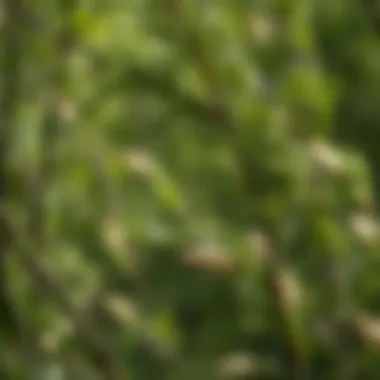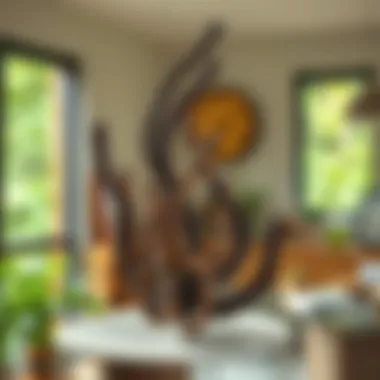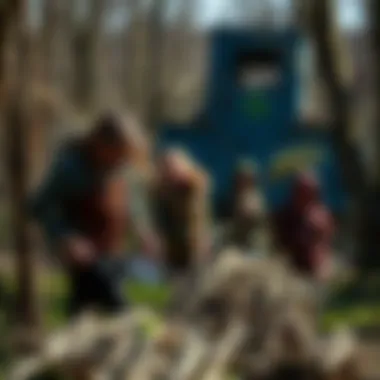Exploring Native Willows: Crafting and Ecology


Intro
The intricate relationship between native willows and bead crafting serves as a testament to both ecological stewardship and cultural heritage. These flexible trees, known for their resilience, grow in various environments and play a critical role in maintaining local ecosystems. Understanding the importance of willows in crafting beads sheds light on sustainable practices that support artistry and preserve natural habitats. This exploration delves not just into the crafting process but emphasizes the vital need for sustainable harvesting methods that protect these resources for future generations.
Overview of Forestry Practices
In order to appreciate the role of native willows in bead crafting, it's essential to grasp the broader context of forestry practices. Foresting involves the management of forested areas and the careful consideration of their ecological balance. The significance of responsible forest management cannot be overstated, as forests are not merely collections of trees, but vibrant ecosystems teeming with life.
Importance of Foresting
Proper forestry practices ensure the survival of native plant species, provide habitats for wildlife, and maintain clean waterways. Specifically regarding willows, understanding how they contribute to soil stabilization and habitat formation is crucial. Their extensive root systems help prevent soil erosion, playing an integral role in maintaining the health of surrounding environments. Thus, the practice of harvesting willows must be carried out with an eye toward minimal impact, ensuring that both the trees and their ecosystems thrive.
Types of Forestry Practices
Different types of forestry practices can impact the sustainability of willow harvesting:
- Selective Logging: This practice involves the careful removal of specific trees, allowing the remaining trees to continue growing and providing ecosystem services.
- Agroforestry: Integrating willows into agricultural systems can enhance productivity while conserving biodiversity.
- Reforestation: Planting new willows after harvesting ensures that this valuable resource remains available for future bead crafting enthusiasts.
Each method carries its own advantages and challenges, and understanding these nuances is vital for anyone engaged in or interested in sustainably crafting with native willows.
Best Practices for Sustainable Woodland Stewardship
Sustainable woodland stewardship is more than a buzzword; it embodies principles that seek to balance human needs with ecological health. Gaining insight into these principles is paramount for anyone involved in bead crafting and ecological conservation.
Principles of Sustainable Forestry
At the core of sustainable forestry lies a commitment to preserving biodiversity, promoting growth, and enhancing the health of forest ecosystems. Key principles include:
- Diversity: Encouraging the growth of various plant species strengthens ecosystems and reduces vulnerability to pests.
- Resilience: Cultivating adaptable yields ensures long-term availability of resources.
- Community Involvement: Engaging local communities in forest management fosters a sense of ownership and responsibility.
By adhering to these principles, bead crafters can ensure that their practices contribute positively to the environment rather than detract from it.
Techniques for Land Management
Effective land management techniques pave the way for successful harvesting of willows. Some widely recognized techniques include:
- Controlled Harvesting: Careful planning around harvest time and methods minimizes disruption.
- Soil Conservation Practices: Ensuring that soil quality remains high supports healthy willow growth.
- Monitoring Health: Regular assessments help identify problems before they escalate, maintaining the vitality of willow populations.
By incorporating such techniques into land management, the balance of ecological health and resource availability can be maintained.
Innovative Techniques in Forestry
As the world evolves, so too does the field of forestry. Innovative techniques emerging in this area offer exciting opportunities for sustainable practices that intersect with bead crafting.
Latest Technological Advancements
Recent advancements, particularly in data collection and analysis, provide valuable insights into forest ecosystems. Technologies such as drones and remote sensing have revolutionized land monitoring and resource management, making it easier to track the health of willow populations and their habitats. These technologies allow for more effective planning and can inform responsible harvesting decisions.
Integrating Traditional Knowledge with Modern Science
Merging indigenous practices with current scientific methodologies presents unique opportunities for enhancing craftsmanship and ecological understanding. Local knowledge regarding willow growth habits, seasonal cycles, and habitat requirements is invaluable. Always consider this wisdom when developing crafting and harvesting techniques. By fostering dialogue between traditional practitioners and modern scientists, a richer understanding of the ecological value of willows emerges.
"The intertwining of nature and craft provides a powerful platform to not only create art but also educate on the importance of sustainability."
In concluding this overview, it is clear that native willows hold a dual role—both as a medium for artistic expression and as a vital component of local ecosystems. The various forestry practices discussed highlight the necessity of mindful engagement with our natural resources. This underpinning understanding lays the groundwork for the ensuing sections, which will further explore the critical techniques and cultural significance tied to willow bead crafting.
Prolusion to Native Willows


The native willows present themselves not merely as ordinary flora; they are pivotal in the context of bead crafting and the environment. Their slender yet resilient stalks, often swaying gracefully in the breeze, symbolize a deep-rooted connection between human creativity and the ecosystem. Understanding the significance of native willows unlocks a treasure trove of information not only about crafting but also their ecological importance and cultural significance in various communities.
In this exploration, we navigate through the various facets of these willows, shedding light on their roles in sustainability and artistry. The aim is to cultivate appreciation—not just for the beauty of willow beads but also for the vital ecosystem services that these species provide. From supporting wildlife habitats to stabilizing soil, native willows embody much more than a resource for craftsmen. They represent threads weaving together ecological health and cultural traditions.
Understanding the Ecology of Willows
Willows, notably belonging to the Salix genus, thrive in a variety of habitats, particularly near water. Their adaptability to different environments not only speaks to their resilience but also to their ecological contributions. The roots of willows dig deep, offering both support for the plant itself and structural integrity to the surrounding soil. This function is critical in preventing erosion, particularly in riparian zones where water and land converge.
Moreover, the foliage plays host to a diversity of organisms—from insects to birds—thereby enhancing local biodiversity. Additionally, willows can absorb excess nutrients from the soil and water, acting as natural filters that improve the quality of surrounding ecosystems.
"Native willows contribute significantly to habitat stability and soil health, underscoring their ecological importance far beyond their ornamental value."
By integrating the crafting of willow beads into our understanding of their ecology, we recognize the overlapping needs of art, nature, and community. This synergy not only supports sustainable practices but also fosters awareness about habitat preservation, making it vital for future generations to continue these traditions with respect and knowledge.
Cultural Significance of Willows
The cultural significance of native willows transcends the bounds of practical application. Historically and contemporarily, many indigenous and local communities have woven stories, traditions, and spiritual practices around these plants. They are often seen as symbols of resilience and adaptability, reflecting the traits that communities value in their own narratives.
In various cultures, the crafting of willow beads stands as a rite of passage or a communal activity, intertwining social ties and shared history. It connects artisans to their heritage, breathing life into forms of expression that celebrate identity and belonging. The patterns crafted into the beads can sometimes tell stories of ancestral lineage or mark important life events, thereby cementing the willows’ role in the cultural tapestry.
Furthermore, as society grapples with modernity and the loss of traditional crafts, native willows serve not only as a resource but as a revival tool. They can reignite interest in ancestral skills and promote cultural heritage, making the discourse around willow crafting as essential as the act itself.
Understanding the cultural significance of willows enriches the broader conversation about bead crafting and ecological sustainability, inviting a shared responsibility to steward both artistic and ecological resources thoughtfully.
Species of Native Willows Used for Beads
The use of native willows in bead crafting showcases not only the artistry associated with this craft but also the ecological and cultural dimensions that come into play. Understanding the specific species of willows suitable for bead making is critical. These species are particularly valued for their properties such as flexibility, strength, and the aesthetic qualities of their bark and branches. Not all willows are created equal, and in bead crafting, certain types are favored for their unique characteristics, which can influence both the crafting process and the final product.
Native willows, primarily belonging to the Salix genus, possess qualities that make them ideal for crafting. Besides being pliable and lightweight, they often feature colors and textures that enhance the beauty of the beads produced. Moreover, selecting the right species helps in achieving sustainability, as some are more abundant and even actively managed for such usages.
Characteristics of Salix Species
The Salix species, commonly known as willows, are trees or shrubs that thrive in moist areas, typically along rivers and wetlands. Each species exhibits distinctive traits:
- Salix interior: Known for its slender branches, it is often favored for its flexibility and smooth texture, making it ideal for intricate bead designs.
- Salix babylonica: While primarily known as the weeping willow, its long, drooping branches are often transformed into flowing, graceful bead creations.
- Salix ciliata: This species has a robust stem with a rugged bark, ideal for creating natural-looking beads that resonate with organic aesthetics.
Understanding these characteristics opens a door to a multitude of design possibilities, enabling artisans to select the most suitable willow types for their projects.
Regional Variations in Willow Types
The geographical distribution of willows introduces a fascinating array of species variations which might appeal differently to bead crafters. For instance, in the northern regions of North America, Salix scouleriana, or Scouler's willow, displays resilience to colder climates, leading to particularly sturdy and frost-tolerant beads.
In contrast, southern climates may host Salix discolor, commonly called the pussy willow, distinguished by its lustrous silvery catkins. This species not only flourishes in warmer weather but also brings a unique visual appeal to bead making due to its silvery hue and soft texture.
Additionally, certain areas might emphasize the ecological importance of harvesting specific species that promote local biodiversity while being utilized in bead crafting. For artisans focused on sustainability, selecting regional varieties reinforces a commitment to preserving native ecosystems while producing beautiful handcrafted items.
Sustainable Harvesting Practices
Sustainable harvesting practices are pivotal when discussing native willows in bead crafting. They ensure that these valuable resources are available for generations. The act of harvesting, in its essence, should not strip the land of its vegetation, but rather promote regrowth and biodiversity. Using willows as a sustainable resource not only ties into native cultural practices but also aligns with modern ecologic principles. The balance between use and preservation greatly influences the health of the ecosystem.
Timing and Techniques for Harvesting
When it comes to timing, the art of harvesting willows is all about knowing when to strike. Willows typically thrive in the spring, a time when their sap flow is abundant. The best practice is to harvest when the tree is just beginning to leaf out. This is when the bark is most supple and the branches easiest to work with.
Some seasoned craftsmen favor using hand tools, such as pruning shears. This method allows for selective cutting, targeting only the strongest and healthiest branches, thereby avoiding damage to the overall structure of the willow. Techniques vary by region and tradition, but the objective remains the same: minimize impact.
One must be cautious not to overharvest. Areas can become barren if too many willows are cut in a single season. A good rule of thumb is to only take a certain percentage of what is available, preserving enough branches to sustain the willow's growth and ecosystem functions.


Impact of Overharvesting
The repercussions of overharvesting can be dire, not just for willows, but for the broader ecosystem. A particularly concerning outcome is the decline of biodiversity in areas where native willows are removed. As willows provide vital habitats for various species, their depletion can lead to decreased populations of insects and birds that rely on them.
"Sustainable practices allow us to enjoy the beauty and utility of willows while safeguarding our natural heritage for future generations."
Another serious concern is soil erosion; willows have deep roots that stabilize soil and prevent washouts. Overharvesting can compromise this structure, leading to increased erosion and alteration of habitats. As such, acknowledging the balance between utilization and preservation is essential.
Crafting Techniques for Willow Beads
When it comes to the craft of bead-making with native willows, the techniques employed not only reflect the skill of the artisan but also highlight the deep relationship between human creativity and nature. Willow beads offer a unique aesthetic, showcasing both natural beauty and human innovation. By understanding and mastering these crafting techniques, individuals can express themselves artistically while fostering a bond with the environment that nurtures these materials.
Basic Methods of Bead Creation
Creating beads from native willows can be a rewarding experience. The groundwork of this process involves several fundamental methods that artisans typically utilize:
- Harvesting the Material: The journey begins by selecting sturdy, flexible willow shoots, often Salix discolor or Salix exigua. Cut these during early spring as they begin to bud; this timing ensures the shoots have the necessary moisture and pliability.
- Preparing the Willow: Once harvested, the willow should be soaked in water for several hours or overnight. This rehydration process makes the fibers easier to work with. It's akin to letting bread dough rise; it’s essential for achieving the desired end product.
- Shaping the Beads: Artisans usually slice the soaked willow into sections, then use their fingers to round the shapes into beads. At this stage, one might find that the natural imperfections add character. The key here is patience—rushing through can yield uneven shapes.
- Drilling Holes: After the beads have dried slightly, tiny holes need to be drilled for stringing. This is where precision is crucial because misaligned holes can disrupt the overall aesthetics when they are strung together.
- Finishing Touches: Once shaped and drilled, artisans may sand the surfaces to create a smooth finish. Some may choose to dye or embellish the beads to add pops of color, further enhancing their natural beauty. The final look can reflect the artisan’s personal style, turning each bead into a miniature piece of art.
Utilizing these basic methods not only facilitates the crafting of beautiful pieces but also serves to educate novices about the integral relationship between materials and craftsmanship in bead-making.
Advanced Knotting Techniques
As crafters grow more comfortable with basic bead-making processes, exploring advanced knotting techniques can open up a treasury of creative possibilities. Knotting offers a way to combine beads, creating intricate patterns and designs that add complexity to the art form:
- Celtic Knots: This technique involves weaving beads in a manner that mimics traditional Celtic patterns. The result is an intricate design that can symbolize unity and continuity.
- Lark’s Head Knot: Often used in jewelry making, this knot allows for easy attachment of beads along cords. It is simple yet effective, functioning well for those looking to create a more dynamic structure with their willow beads.
- Square Knot: This knotting style provides a sturdy connection, suitable for more substantial weighted beads. It creates a flat, neat appearance that holds finished pieces securely without adding bulk.
"Mastering these techniques allows crafters not just to create jewelry, but to tell stories through their designs."
- Macramé: This traditional knotting technique can be combined with willow beads to create larger pieces, such as wall hangings or plant holders. It allows for greater freedom of expression; with varying knot types and patterns, the artist can truly customize each piece.
By diving into these advanced techniques, artisans can transcend basic bead-making, weaving intricate narratives through knot patterns that reflect their heritage and artistry. The fusion of willow beads and knotting isn’t merely craft; it’s a dance between nature and creativity, echoing the harmony sought in both art and ecology.
Artistic Applications of Willow Beads
The exploration of artistic applications for willow beads unveils a rich tapestry of creativity, cultural expression, and functionality. Willow beads are not just ornamental; they hold significant artistic merit and contribute to contemporary artistic practices. This section delves into how these natural materials are being integrated into modern artwork and the powerful impact they have on cultural revitalization.
Integration into Contemporary Art
In today’s art scene, the revival of traditional crafting methods, including the use of native willows, has sparked a movement where artisans merge old with new. Willow beads are now being incorporated into a variety of contemporary art forms. For instance, artists are using these beads in installations, jewelry, and textile designs. The texture and organic shapes of willow beads complement various media, allowing for an exploration that breaks the conventional molds of artistic expression.
Willow beads offer unique characteristics that can enhance artwork. Their lightweight nature makes them easily adaptable, allowing artists to experiment with scale and form. They can be dyed or left in their natural state, thus providing a spectrum of visual appeal. Moreover, the ecological aspect of using sustainably harvested materials adds a layer of meaning and narrative to the art itself, encouraging an audience to think critically about environmental stewardship and resource use.
Some artists also use willow beads as a method for storytelling. Each bead can represent a personal journey or a cultural anecdote, thus allowing for a dialogue between the artwork and the viewer. The integration of willow beads into contemporary art not only honors traditional practices but also reinvents their significance in today's world, inviting a fresh perspective on materials that have long been overlooked.
Cultural Revitalization through Crafts
The crafting of willow beads is more than just a pastime; it is a bridge connecting generations and revitalizing cultural heritage. As communities embrace traditional practices, there is an inherent revitalization of shared history and identity. Willow bead crafting opens avenues for social cohesion within communities, fostering collaboration among artists and artisans.
Craft circles are becoming common in various regions, where participants gather to learn the techniques of willow bead making. This not only preserves the knowledge and skills associated with this craft but also strengthens communal bonds. Participants often share stories, songs, and traditions while crafting, which deepens the connection to their cultural roots.
Furthermore, the act of creating is a form of resistance against the fast-paced, mass-produced world. By focusing on handcraft and local materials, artisans signify commitment to sustainability and quality, contributing to greater appreciation for handmade goods.
Educational Opportunities with Native Willows
The interplay of education and practical engagement with native willows opens a door to understanding both environmental science and cultural heritage. Emphasizing educational opportunities not only enriches learners' perspectives but also actively involves communities in preserving and utilizing these vital resources. The initiative revolves around a few key elements, including hands-on workshops, community outreach, and collaborative learning environments that celebrate the heritage and ecological significance of willows.
Workshops and Community Engagement


Workshops centered around willow crafting can serve as dynamic platforms for participants to gain hands-on experience while fostering a sense of community. Whether hosted in local arts centers or community gardens, these workshops offer various benefits:
- Skill Development: Attendees learn traditional and contemporary techniques in bead-making, enhancing their creative abilities.
- Cultural Appreciation: Participants gain insights into the cultural history tied to willow use, bridging generational knowledge with modern practices.
- Environmental Awareness: By understanding the ecological role of willows, attendees become advocates for sustainable practices in their own communities.
These workshops can be tailored to various age groups, from children eager to explore nature to adults seeking to deepen their crafting skills. Engaging narratives can be woven into the experience, highlighting the historical relevance of willows in local indigenous cultures and contemporary art.
As these workshops grow, they may incorporate community involvement in the form of collaborative projects, such as creating a local willow garden or contributing to public art displays. These shared experiences not only bolster community ties but also instill a collective responsibility for environmental stewardship.
Promoting Environmental Stewardship
The role of native willows in promoting environmental stewardship extends beyond crafting; it encapsulates an educational approach that encourages a deeper respect for nature. By engaging with the ecological aspects of willows, individuals can appreciate their significant contributions to preserving biodiversity and combating soil erosion.
- Ecological Education: Workshops can include lessons on the ecosystems supporting willows, discussing their importance for pollinators and local fauna.
- Sustainable Use Practices: Teaching participants about responsible harvesting and regeneration invites a closer attachment to the land, promoting sustainable practices in local environments.
- Encouraging Advocacy: As participants develop a bond with the willows they work with, they become more likely to advocate for preservation efforts, understanding their essential role in habitats.
"Educating communities about the ecological importance of native willows fosters a sense of ownership and responsibility towards the environment."
Lastly, effective outreach should emphasize the potential of native willows in broader environmental contexts, linking the craft of bead-making with global sustainability challenges. Connecting local practices to larger ecological narratives enriches the educational experience and instills a sense of purpose in stewardship activities.
Ecological Impact of Using Native Willows
The role of native willows extends far beyond the realm of bead crafting; they play a crucial part in their ecosystems. Understanding the ecological impact of using native willows is vital for appreciating their significance in bead craft. Native willows contribute to biodiversity, enhance habitat preservation, and provide solutions for environmental challenges such as erosion control. Utilizing these plants sustainably ensures that both cultural practices and ecological health can flourish simultaneously.
Biodiversity and Habitat Preservation
One of the most significant benefits of native willows is their ability to support biodiversity. Willows provide shelter and food for numerous wildlife species, ranging from birds to insects. Their adaptability allows them to thrive in various environments, which makes them important components of wetland areas, riverbanks, and floodplains. In fact, the presence of willow species can be a strong indicator of a healthy ecosystem. For instance:
- Habitats for Wildlife: Birds often utilize willow thickets for nesting. Species like the yellow warbler find shelter among the leafy branches, thriving in the rich environment that willows create.
- Support for Insects: Willows support a diverse array of insects, including those that pollinate other plants. This interaction enables a dynamic food web that benefits many other organisms within the ecosystem.
- Nutrient Cycling: The fallen leaves and branches decompose, contributing nutrients back to the soil, further enhancing plant growth in the area.
Using native willows for bead craft can contribute to habitat preservation as well. Sustainable practices that include careful harvesting ensure that the surrounding ecosystem remains intact. By integrating willow crafts into local culture, communities can strengthen their connection to the land and advocate for the importance of maintaining healthy habitats.
The interdependence of species supported by willows exemplifies the principle of biodiversity; a robust ecosystem relies on each player's role.
Role in Erosion Control
Another significant ecological impact of native willows is their effectiveness in controlling erosion. Their root systems are particularly effective at stabilizing soil and preventing the loss of land along riverbanks and slopes. This contribution is essential to maintaining the integrity of waterways and preventing sedimentation issues in aquatic environments. Some key points include:
- Root System: Willows possess deep-rooting systems that anchor soil effectively. The roots intertwine and create a matrix that resists erosion.
- Water Absorption: By absorbing excess water from the soil during heavy rainfall events, willows play a vital role in managing water runoff. This way, they reduce the likelihood of flooding in surrounding areas.
- Soil Health: Healthy willows lead to healthy soil. Their organic matter enriches the soil structure, promoting further plant growth and reducing erosion risks.
Incorporating native willows into bead crafting practices not only honors traditional methods but also promotes environmental stewardship. It’s about striking a balance between artistic expression and ecological mindfulness. This delicate relationship highlights how time-honored crafts can coexist with sustainable ecological practices.
Epilogue: The Future of Native Willows and Bead Craft
The future of native willows in bead crafting stands as a critical crossroad where ecology and culture meet. This intersection is not just pivotal for artisans but also holds significant implications for ecological sustainability. Understanding and promoting this connection can usher in a new era of creativity that respects both our natural environments and cultural heritage.
Sustaining Cultural and Ecological Values
To maintain the rich tapestry of cultural values related to native willows, we must look at ways to harmonize bead crafting practices with ecological integrity. This involves more than just the physical act of crafting; it's about preserving the stories and histories entwined with these plant species. The willows hold memories for various Indigenous tribes. They are symbols of resilience and identity, passed down through generations. This legacy is worth its weight in gold.
- Perpetuating Knowledge: Workshops and educational programs that focus on traditional bead-making techniques help keep the cultural practices alive.
- Community Involvement: Engaging local communities not only empowers artisans but also fosters a shared sense of responsibility towards these natural resources.
- Respecting Nature: Practicing sustainable harvesting techniques ensures that the willows thrive, maintaining the delicate balance of local ecosystems while allowing artisans to continue creating.
Collaboration between artists and ecologists can lead to innovative practices that benefit both art and nature. Understanding the right seasons to harvest and applying minimal intervention techniques can sustain willow populations for future generations.
Path Forward for Native Willow Practices
Looking ahead, the incorporation of native willows into the crafts industry should align with larger environmental goals. The development of policies that endorse sustainable practices is crucial. Such policies can encourage artisans to adopt harvesting methods that minimize ecological footprints. Strong advocacy for these practices, perhaps through grants, can also provide additional motivation for economically challenged artisans.
"Sustainability is not just about using resources responsibly but also about respecting the communities that rely on these resources."
The role of technology in this landscape cannot be overlooked. Digital platforms can connect artisans with relevant information on sustainable practices and market opportunities. Think of how social media can be a push for local artisans to engage a broader audience and cultivate demand for ethically produced willow beads. This exposure can yield a supportive community that values cultural authenticity and ecological responsibility.
Furthermore, research into new species of willows that might be suitable for bead-making will expand options for artists while also taking into account climate adaptability and resilience. Careful consideration of these factors will help fortify the future relevance of native willows in bead craft.
As we move into a more interconnected future, the narrative around native willows must transform from a mere history into a dynamic story of resilience, creativity, and respect for the planet. Only then can we hope to see the full potential of native willow practices unfold, ensuring that this artisanal craft remains vibrant and ecologically sound for generations to come.















